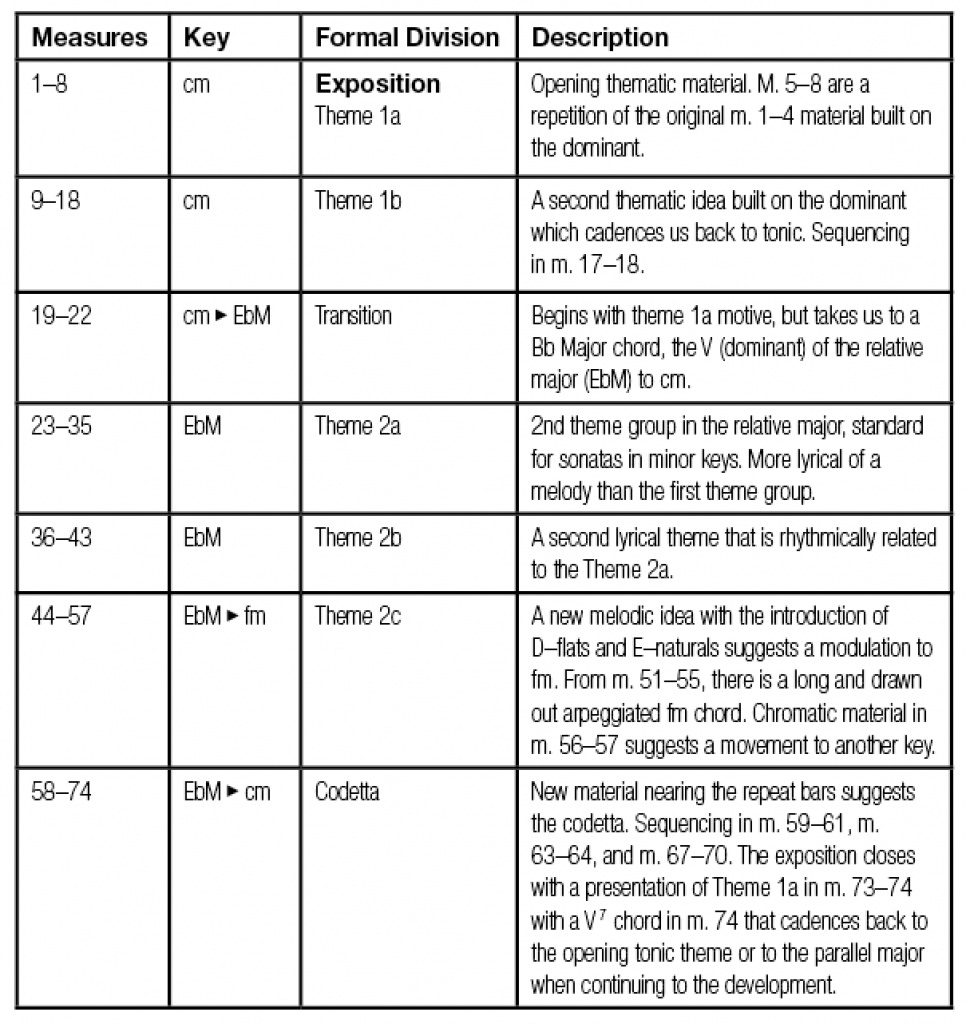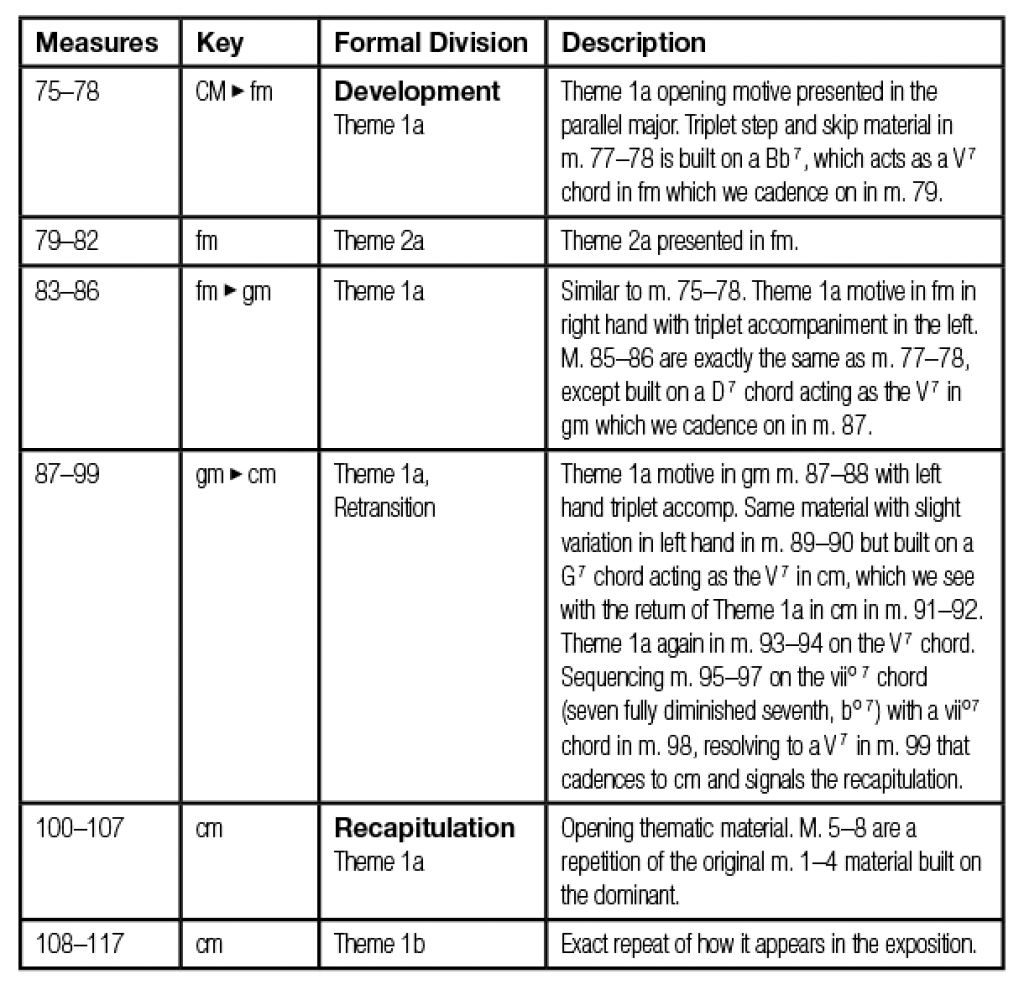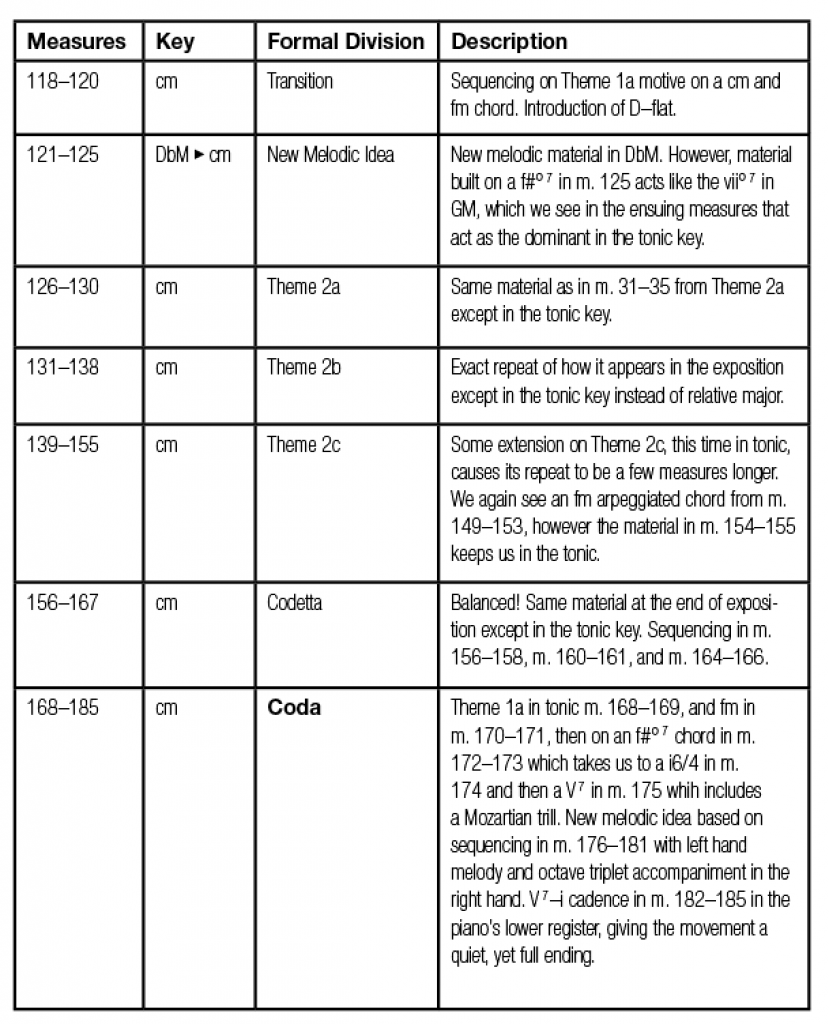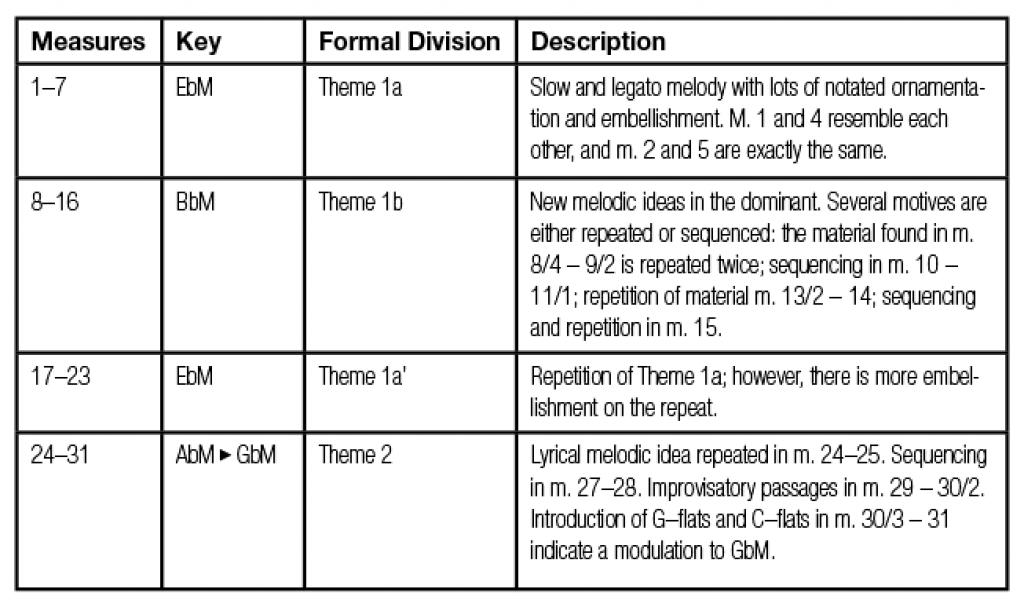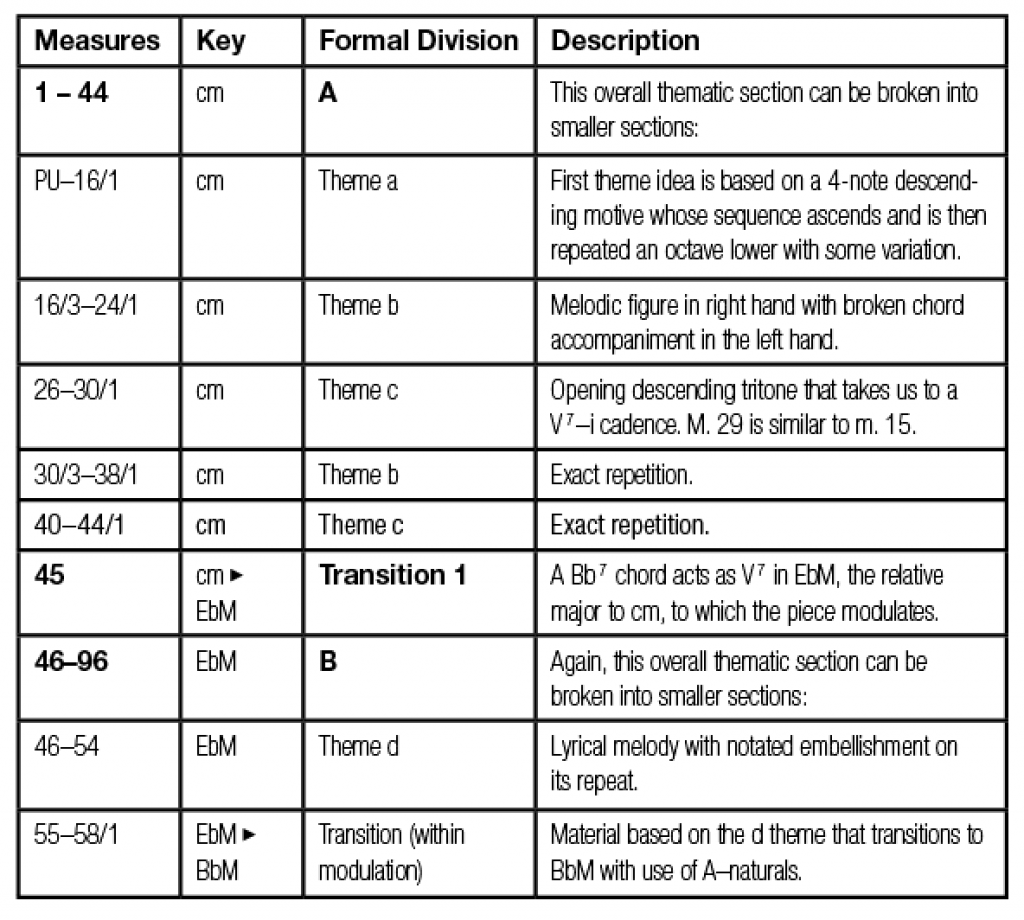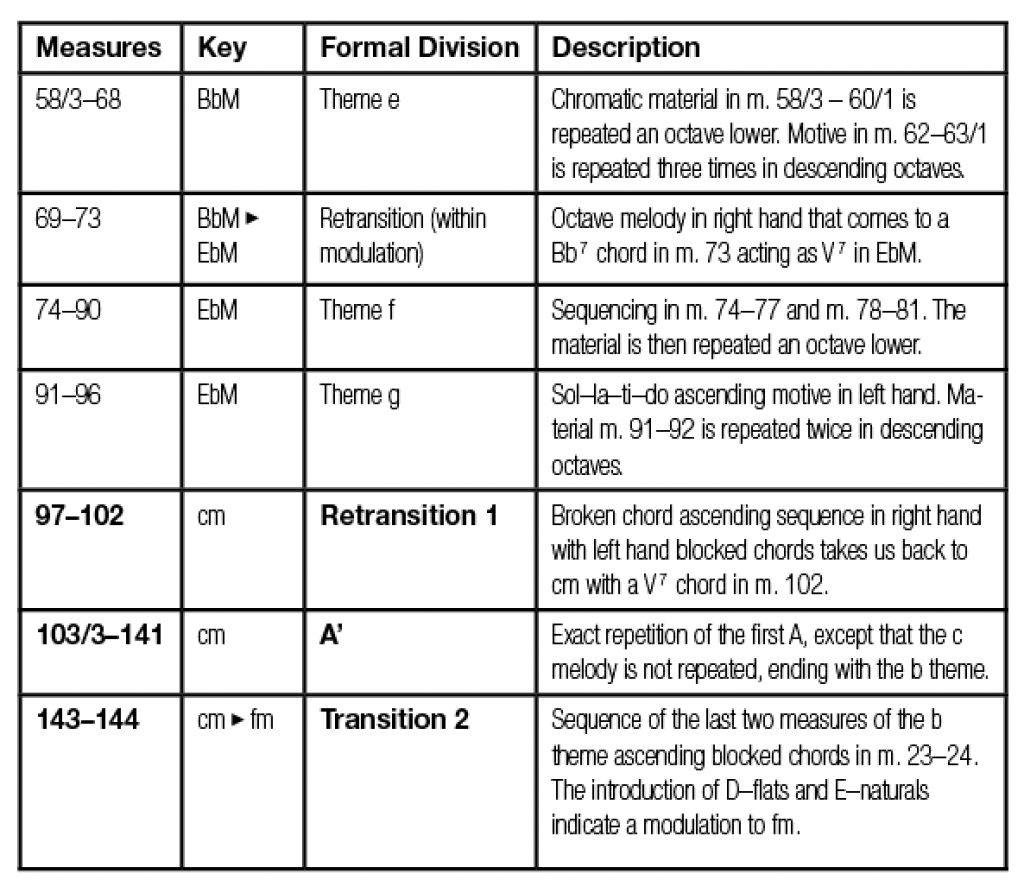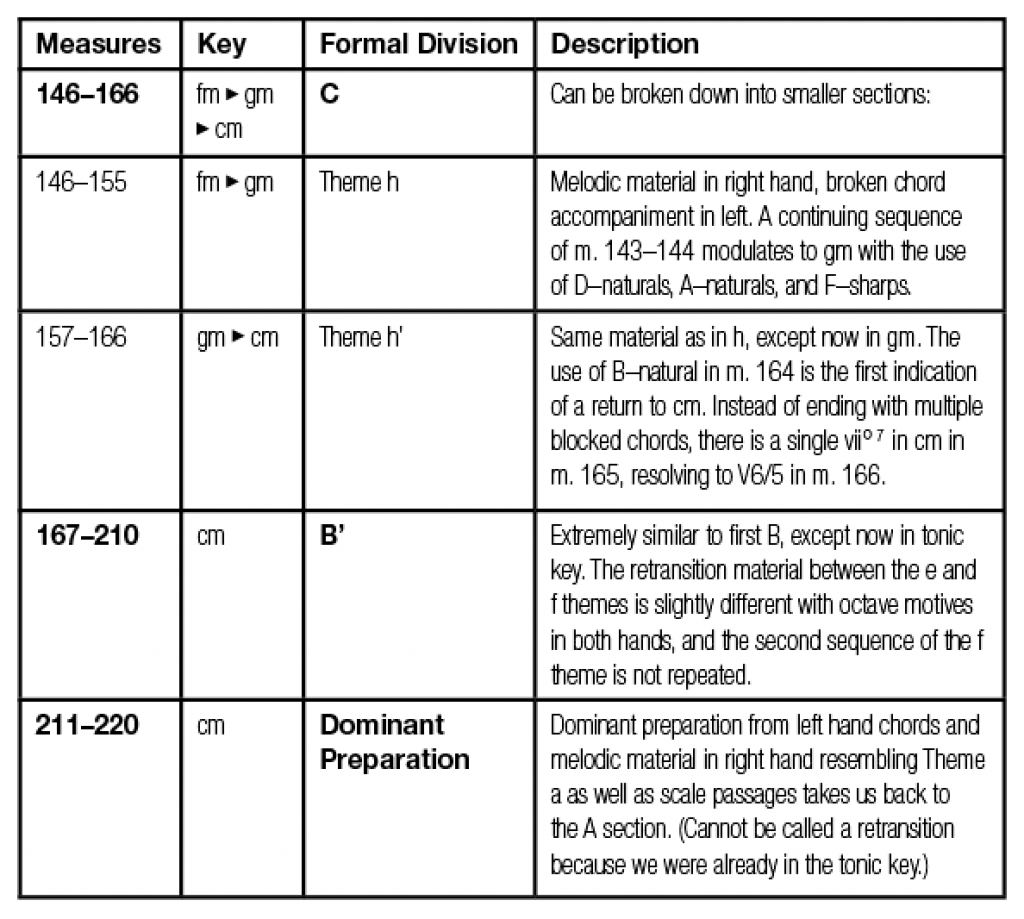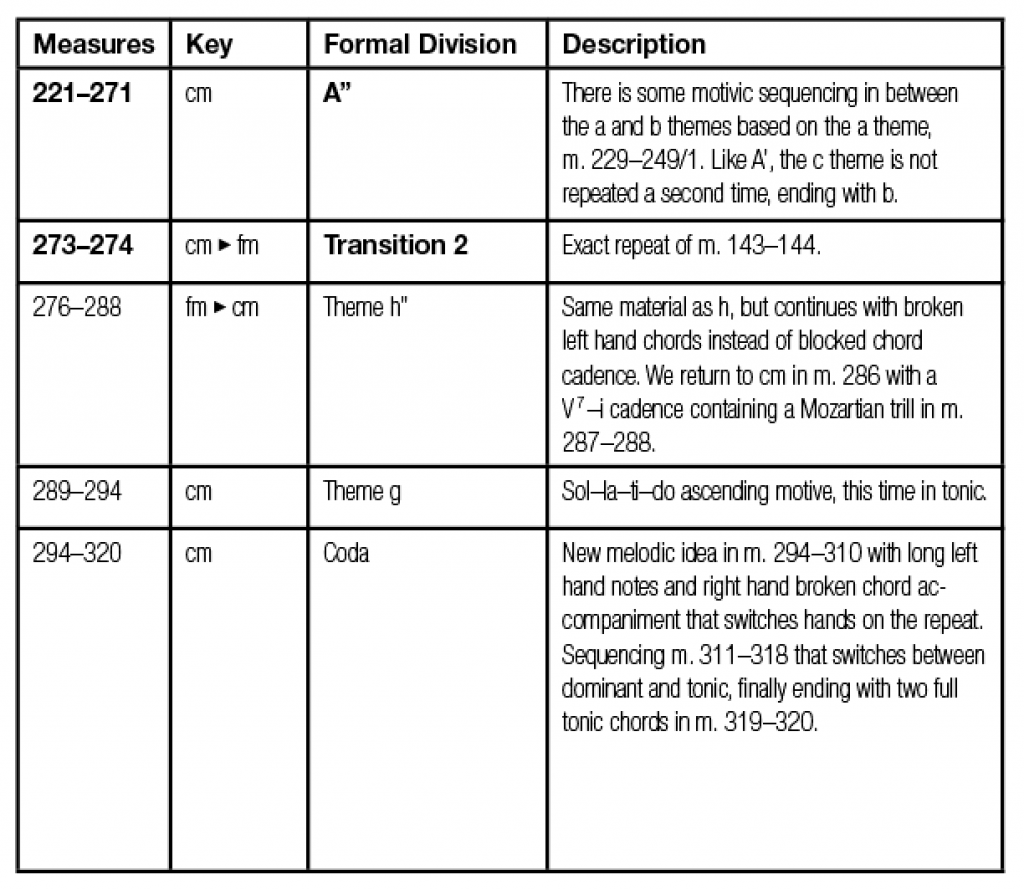Leah G. Parr, author
Dr. Gordon Ring, faculty advisor
awarded first place for best humanities paper
Although the term “sonata” was coined in the early Baroque era, it became a widely used form during the Classical era. Wolfgang Amadeus Mozart (1756-1791) was a Classical composer who used and contributed to the development of this form. A prolific composer, Mozart created successful compositions in all genres, including symphonies, masses, chamber works, solo instrumental sonatas, and opera, often employing sonata form into multiple genres. Out of his seventeen sonatas for solo piano, his Piano Sonata No. 14 in C Minor, K. 457 is considered one of the most important. Composed in three movements, it is a good example of sonata form due to its adherence to the standard textbook definition, but also because of its differences and ensuing exploration of formatic ideas.
Mozart was born in Salzburg, Austria on January 27, 1756 to Leopold and Anna Maria Mozart. Leopold, also a composer, was Mozart’s primary source of education at the beginning of his life (Eisen). Showing virtuosic musical talents from an early age, Mozart began composing and performing at age five along with his sister Nannerl. Beginning in 1762, Leopold took both Mozart and Nannerl on several European performance tours in order to play for royalty and members of the nobility, visiting locations such as Paris, London, Vienna, and Italy. It was these trips during Mozart’s early years that exposed him to various styles of music, “[developing him] into an international composer” (Gordon 123).
After his lengthy performance career, Mozart returned to Salzburg, where he served as the Konzertmeister to the Archbishop of Salzburg from 1769-1781. Mozart battled several conflicts during this period, including disagreements with the Archbishop and his father, as well as the death of his mother while living in Paris in 1778. An insensitive ruler, the Count of Colloredo was appointed to the Archbishop position in 1782, and was not fond of music (Gordon 124). Although this caused Mozart’s position to become uncomfortable, his compositions still flourished, composing several masses during this time (Eisen). Conflicts with his father also produced tension as Mozart wanted to move on to other places of employment, but Leopold wanted him to stay in Salzburg with a reputable position. Unhappy, Mozart ultimately decided to move to Vienna in 1781 where he could explore other compositional realms.
In Vienna, where he lived until his death, Mozart free-lanced; one of the first composers to do so as previous ones, such as Johann Sebastian Bach (1685-1750) and Franz Joseph Haydn (1732-1809), had been employed in church and court positions. He established a reputation of being the finest Viennese keyboard player in addition to a pedagogical reputation as he took on several students (Eisen). It was during the Vienna period that Mozart composed his most successful and masterwork operas that are still performed today. Free from the Archbishop’s oppression, Mozart was able to explore secular themes that provide the basis for his greatest operas. He died in Vienna on December 5, 1791 due to unknown causes.
Musicians everywhere regard Mozart as a spontaneous character who lived life to the fullest. He married Constanze Weber on August 4, 1782, after which they lived a lavish lifestyle, sending them into debt due to Mozart’s ghastly spending habits and inability to manage money. However, he is considered one of the greatest musical geniuses to ever walk this earth. His ability to compose great music quickly and efficiently allowed him to produce a large amount of repertoire in every genre. His superb knowledge in theory and form contributed to the “virtually flawless” quality of his music (Gordon 125).
The word sonata comes from the Latin word sonare, meaning “to sound.” In early seventeenth-century Baroque music, this term was applied to music that was to be played by instruments instead of sung (Gordon 34). First used by Adriano Banchieri (1567-1634), the term reflected the increased use of instruments in music as compared to Medieval and Renaissance music, which was mainly vocal/choral (Gordon 45). At this point in time, dance suites, church suites, and sonatas were musically identical, producing works of four or more movements in alternating slow-fast tempi. These movements in themselves had their own form, usually a binary dance form with two distinct sections. It was this multi-sectional structure that lead composers to label their compositions as sonatas (Gordon 74).
Eventually, the sonata developed into a three-movement piece with a fast-slow-fast format. Two composers influenced this: Alessandro Scarlatti (1660-1725) and Georg Christoph Wagenseil (1715-1777). Scarlatti’s opera overtures, formatted into fast-slow-fast sections, were “expanded into a pattern on which the sequence of movements in the sonata were based” (Gordon 75). Wagenseil broke away from the multiple movement structure and wrote pieces with just three movements in the fast-slow-fast manner (Irving 19).
The most identifiable form element of a three-movement sonata is the single movement sonata form, typically used in the first movement. This form, although not theoretically labeled until the mid-nineteenth century, “is a three-section design consisting of exposition, development, and recapitulation of two principal themes, labeled respectively the first and second subjects” (Irving 99). In the exposition, the first theme is presented in the tonic key and the second theme in either the dominant (if the tonic is major) or relative major (if the tonic is minor). In the development, these themes are basically developed and possibly expanded in various keys, with a return to the first tonic theme signaling the recapitulation, in which both themes are in the tonic key.
This idea of multiple themes and modulations was first explored by Domenico Scarlatti (1685-1757), an early Classical composer, in his 555 sonatas. Although his sonatas were single binary movements, they have two thematic ideas and modulatory sections; the first section consists of the first theme, presented in tonic and the second theme in dominant/relative major that modulates to that key. In the second section, there is a return to tonic in which both themes are presented (Gordon 76). Other early Classical developments included the use of left hand accompaniment to right hand melodic material, a technique explored and made popular by Haydn (Gordon 93).
Eventually, there were prevailing forms for each of the three sonata movements. Single movement sonata from is statistically the most likely for the first movement, although theme and variations is also popular. The second and slow movement is typically an ABA-like form, with menuet and trio being a popular option as sonatas developed out of dance forms. The last movement could be set in various forms with the rondo, a form in which thematic material alternates with contrasting material in closely related keys, being the most used.
Mozart’s Piano Sonata No. 14 in C Minor, K. 457 follows this standard practice as the first movement is in single movement form, the second movement is a drawn out ABA, and the last movement resembles a rondo. Completed on October 14, 1784, this piece was composed during Mozart’s Vienna years. It was published in 1785 as Fantasia and Sonata in C Minor, containing both Fantasia in C Minor, K. 475 and the Sonata. Although composed at different times (the Fantasia was finished on May 20, 1785), the two pieces are musically similar, with some believing that Mozart viewed the Fantasia as an extended prelude to the Sonata (Wolf 5-6).
When published by Artaria, the set was dedicated to Therese von Trattner, a student of Mozart. In reference to the autography of this piece, it is suggested that the Sonata’s middle movement was written before the others as a possible teaching piece for Trattner (Wolf 22). Holding much “pedagogical significance,” the movement showcases Mozart’s compositional development in terms of variation and ornamentation (Irving 74).
The titles for the Sonata’s three movements are “Allegro,” “Adagio,” and “Molto Allegro.” Although they bear great similarity to the textbook definitions of the corresponding individual forms, there are also many differences that make this piece unique. A typical performance lasts eighteen minutes.
FORM CHARTS
I “Allegro”
II. “Adagio”
III. “Molto Allegro”
The first movement, “Allegro,” is a standard single movement sonata form. Lacking the optional introduction, the exposition begins with the first theme group in the tonic key followed by a transition leading to the second theme group in the relative major, as the tonic key is C minor. The development is short, with thematic development from both theme groups. These themes are development in closely related keys, including F minor, the subdominant minor, and G minor, the dominant minor. The return of the recapitulation is signaled by the return of the first theme group. Thus, this movement closely follows the textbook definition of single movement sonata form.
There are several interesting characteristics about this first movement. The first theme in C minor is a reference to the orchestral gesture known as the Mannheim rocket (Gordon 135). This gesture is an “upward-shooting set of [arpeggiated] patterns” that is not only found in the exposition, but is also developed in the development (Smallman).
Example 1 Wolfgang Amadeus Mozart: Sonata, K. 457, 1st movt. m. 1-4.
Comparisons have been made between this sonata’s opening movement to that of Sonata in F Minor, Op. 2, No. 1 by Ludwig von Beethoven due to its “brusque, strong character” in addition to the use of the Mannheim Rocket (Gordon 135). To contrast this strong opening, Mozart includes lyrical and smooth melodies in the second theme group in E-flat Major. This melodicism can be attributed to his success as an opera composer.
Three aspects of the “Allegro” movement oppose the textbook form. It is a standard compositional practice to include dominant preparation material in the retransition back to tonic between the development and the recapitulation. Although we do see one measure built on the dominant seventh chord, there is more material built upon the seven fully diminished seventh chord right before the recapitulation. Typically, both theme groups presented in the exposition are in the tonic key during the Recapitulation, C minor in this instance. However, after repeating the first theme group, Mozart introduces new melodic material in D-flat Major, the supertonic major, instead of presenting theme 2a in the tonic (Gordon 135). Another common practice is to balance the material at the end of the exposition and the recapitulation, and have that serve as the movement ending. However in this piece, there is an additional coda, after the repeat bars signaling the end of the balanced Recapitulation. The coda begins with the Mannheim Rocket opening motive, as seen below and introduces a new melodic idea before ending on a motivically developed authentic cadence.
Example 2 Wolfgang Amadeus Mozart: Sonata, K. 457, 1st movt. m. 168-171.
The “Adagio” definitely serves as the slow middle movement piece. Because it is believed that this movement was written separately from the outer movements, it does not have a typical form found within a sonata, and is vastly different from the intense outer movements (Irving 75). It is slow moving, lasting almost twelve minutes, and free, with some thematic development (Gordon 135). Essentially, it is an ABA form in E-flat Major, the relative major to C minor. The A section is rounded in itself, with a first theme in tonic and a second that modulates to the dominant B-flat Major, as seen below, closing with an embellished return of the opening theme.
 Example 3 Wolfgang Amadeus Mozart: Sonata, K. 457, 2nd movt. m. 14-15.
Example 3 Wolfgang Amadeus Mozart: Sonata, K. 457, 2nd movt. m. 14-15.
In fact, each time the melody is repeated it is continuously developed and embellished.
The B section introduces a new melody that is repeated in multiple keys. Comparisons have been made between this melodic figure and the one found in the second movement of Sonata in C minor, Op. 13 “Pathetique” by Beethoven, as they both start with the same notes: C, B-flat, and E-flat (Gordon 135-136). (In fact, comparisons have been made between the entirety of both sonatas due to their organizational layout.) There is chromatic and cadenza like material before the return of the A section, which not only develops the first theme, but includes the second theme in the tonic key of E-flat Major:
 Example 4 Wolfgang Amadeus Mozart: Sonata, K. 457, 2nd movt. m. 56-57.
Example 4 Wolfgang Amadeus Mozart: Sonata, K. 457, 2nd movt. m. 56-57.
“Molto Allegro” returns the piece to its C minor tonal center and fiery personality. Fundamentally a rondo, it can be labeled as ABACBAC and coda (Gordon 136). It differs from a standard rondo in that the sections are much longer, containing more melodic material, and how the A section does not repeat between each episode. Although there are several identifiable melodies, this movement uses more motivic sequencing than the previous two. Its fragmented sections and frequent rest breaks contribute to the movement’s “searching restlessness” and “elusive and disturbed” mood (Gordon 136). However, all modulatory sections are in closely related keys, with some material repeated later on in the tonic key. For example, the first time we see the B theme, it is in the relative major:
 Example 5 Wolfgang Amadeus Mozart: Sonata, K. 457, 3rd movt. m. 47-50.
Example 5 Wolfgang Amadeus Mozart: Sonata, K. 457, 3rd movt. m. 47-50.
The second time we see this theme, it is in the tonic:
Example 6 Wolfgang Amadeus Mozart: Sonata, K. 457, 3rd movt. m. 168-171.
The closing movement “works admirably as the final dramatic touch for this sonata” (Gordon 136).
Made popular in the Classical era by composers such as Wolfgang Amadeus Mozart, the sonata became a standard and popular form that is still significant in compositional realms today. Mozart’s Piano Sonata No. 14 in C Minor, K. 457 significantly represents the textbook definition of sonata form in terms of thematic development and key relations. Although composed in 1784, it remains in the performance repertoire today, to be enjoyed by listeners of all ages.
Works Cited
Bass, Richard. “The Second-Theme Problem and Other Issues in Mozart’s Sonata K. 457.” Indiana Theory Review 9.1 (1988): 3-21. Web.
Cliff Eisen, et al. “Mozart.” Grove Music Online. Oxford Music Online. Oxford University Press. Web. 17 Nov. 2015.
Gordon, Stewart. A History of Keyboard Literature: Music for the Piano and Its Forerunners. Belmont, CA: Schirmer Cengage Learning, 1996. Print.
Irving, John. Mozart’s Piano Sonatas: Contexts, Sources, Style. Cambridge: Cambridge University Press, 1997. Print.
“Piano Sonata No. 14 (Mozart).” Wikipedia. Wikimedia, 17 Nov 2015. Web. 9 Sept 2015.
Sandra Mangsen, et al. “Sonata.” Grove Music Online. Oxford Music Online. Oxford University Press. Web. 17 Nov. 2015.
Smallman, Basil. “Mannheim school.” The Oxford Companion to Music. Ed. Alison Latham. Oxford Music Online. Oxford University Press. Web. 17 Nov. 2015.
Wolf, Eugene K. “The Rediscovered Autograph of Mozart’s Fantasy and Sonata in C Minor, K. 475/457.” The Journal of Musicology 10.1 (1992): 3-47. Web.
“Wolfgang Amadeus Mozart.” Wikipedia. Wikimedia, 17 Nov 2015. Web. 17 Nov 2015.

